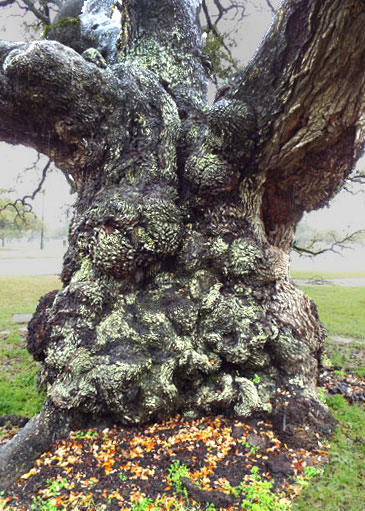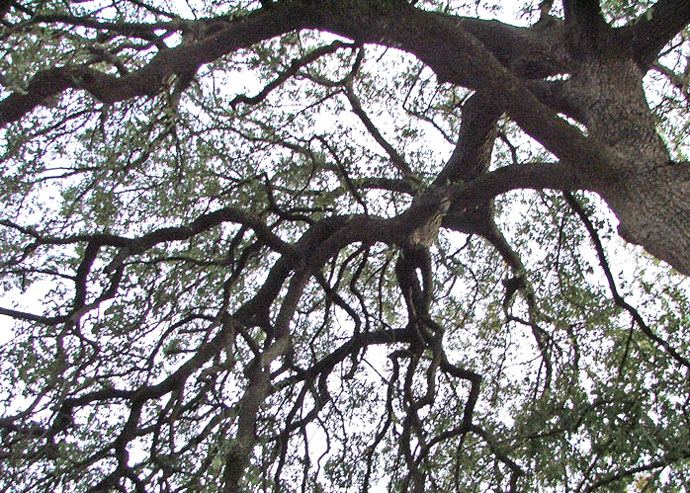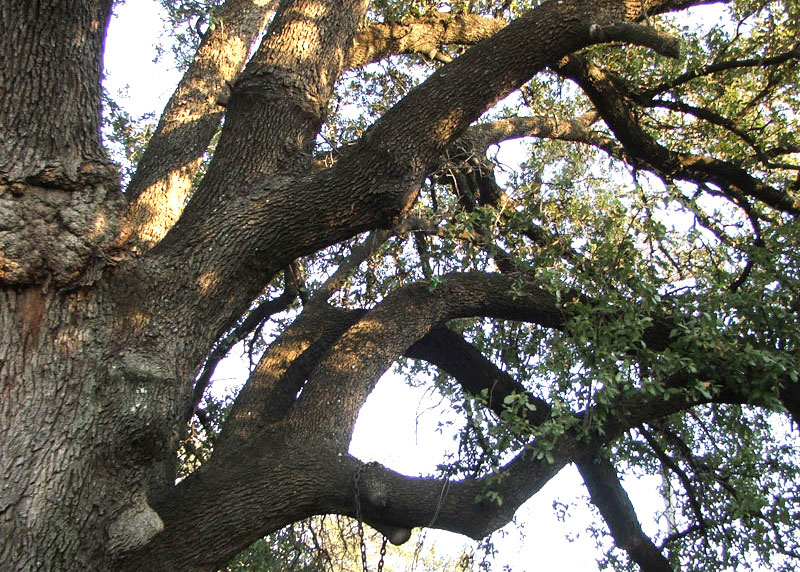Native Son: Live Oak
Sittin’ out here on the porch, basking in this rich darkness of a relatively warm February night in Fort Worth. Not just any darkness. I’m talking about that deep, cavern-like darkness that envelopes you and cradles you, literally, within her bosom. Massive Live Oak trunks, cloaked in dark, deep-furrowed bark, erupting from the earth and wildly flung forth, like a giant Medusa’s hair of twisting, writhing serpentine limbs … yet somehow all this fury and chaos peacefully coalesces into harmony, forming a living, breathing cathedral of beautiful bark and pale green leaves … under which I now reside.
Live Oak (Quercus virginiana) has always been one of my favorite native Texas trees. I find them stately. And you know (don’t say it) I’ve often thought that (don’t say it) well, when you think about it (don’t say it) I would have chosen the Live Oak over the much-beloved Pecan for the Texas State Tree (now you’ve done it) but no one asked me.
To me, Live Oaks personify Texas … rugged for sure, but also graceful and lovely. Enduring beauty … check out Austin’s Treaty Oak, the Big Tree in Rockport, and The Columbus Oak. All those little Hill Country towns that live daily life in, under, and through the tangle of all those Live Oaks. And shouldn’t Texas have a designated Willie Nelson tree?
Hard to believe that sometime within the next 45 days, I will likely curse the nice person who planted these Live Oaks years ago.
As Spring approaches, with its mid-March through early May cavalcade of fabulous floral superstars, the Live Oaks wait patiently … patiently … waiting for the right moment … hmmm, company from out of state … perhaps March Madness BBQ weekend … a nice wedding, you say … to drop a bazillion leaves all over all this fresh, clean springtime tableau. Oh, and Neil tells me that he and Lynn were just in Houston last week, and the out-of-phase “autumn” was already in full swing there.
So you run out there and rake and sweep and rake and haul all those stiff little leaves to the compost pile. You rock! By the time you’re parked in your favorite chair and you’ve got your finger on the pull tab of a cold beer, you look out the window to survey your handiwork … whammo! You look at yourself in the mirror and swear you just cleaned it all up … but there it is … right where the leaf piles once ruled.
Catkins. Lots of catkins. Male Live Oak flowers are arranged on drooping structures called catkins. Basically, these catkins are like four-inch-long limp pipe cleaners that hang off the tree in clusters of 10 to 30. And they’re cute. Cute like Tribbles. And numerous like Tribbles. How many, you ask? Well, there’s the story of an Aggie grad student assigned to count the catkins on A&M’s famous Century Tree … he was almost finished when he fell out of the tree … thank heaven his Medicare had just kicked in.

BUT, the catkins can be useful! Because they fall after the leaf drop, they can be collected separately. In their dry condition, these catkins are lightweight and fluffy. Personally, I use them to top-dress my newly-planted containers around the garden … and maybe even a flower bed. They’re gorgeous for a month or three, then just kind of melt down into a flat nothingness.

This is our first time living under the canopy of Live Oaks … got three; two are better than 42” DBH. Heavy shade is an understatement. Just a sprig or two left here and there of a previous failed attempt at a lawn under here. I’m thinking about planting a few things after leaf fall.
I’ll keep you posted!
Peace & Love, Steven
_________________________________________________________
I need a road trip! Let me know if you’d like me to come and speak to your group sometime. I’m low maintenance, flexible, and you know I like to go just about anywhere. No city too big; no town too small. Just send me an e-mail at stevenchamblee@yahoo.com and we’ll work something out.


